Insider Brief
- A video of quantum computing development points out that several technologies used in the process originate from non-Chinese sources.
- The video was aired on state-owned China Central Television last year.
- Experts say there is no evidence that these company violated US chip export controls.
Asia Times is reporting that a recently surfaced video shows that Origin Quantum, a pioneer in quantum computing, has disclosed the details of its production line, underscoring the substantial reliance on foreign technology in its production. The disclosure, made during an interview with state-owned China Central Television (CCTV) last year and now available online, has offered an unprecedented view into the intricate process of quantum chip production, the news organization points out.
The Anhui Quantum Computing Engineering Research Center, a collaborative effort between Origin Quantum and the Key Laboratory of Quantum Information of the Chinese Academy of Sciences, has been a key partner in the company’s quantum efforts. In the video, Jia Zhilong, the deputy director of the center, meticulously outlined each step and apparatus employed in the chip manufacturing process, highlighting the international nature of the technology.
German Precision in Lithography

The initial phase of the production uses lithographic technology imported from Germany, according to Asia Times. The MA/BA8 Gen4 mask aligner, a crucial piece of equipment in this process, is manufactured by SÜSS MicroTec. This German company, established in 1949, has evolved from a distributor of optical instruments to a leader in photomask business, a transition marked by its acquisition of California-based Image Technology in 2001, the Times reports.
Chinese and International Collaboration in Coating and Oxidation
Next, the chip undergoes a coating and oxidation process in a machine crafted by Yuomao Technology, a Xiamen-based firm founded in 2018. Interestingly, Yuomao Technology was backed by US venture capital firm Sequoia Capital. Last summer, Sequoia announced it would split off its Chinese and Indian/Southeast Asian businesses into two independent firms, as a result of simmering US-China tension.
In this phase, an electronic beam is used to evaporate superconducting metal, such as niobium aluminum, depositing a nanometer-thin layer onto the wafer. The origin of this e-beam lithography technology, crucial in the process, was not disclosed in the video. The Asia Times report suggests, because Japan is a global leader in e-beam lithography technology, a Japanese firm may be involved.
South Korean Expertise in Defect Checking
The subsequent stage involves checking the wafer for defects, using a rapid thermal processing machine from South Korean firm Real RTP. This machine plays a vital role in altering the wafer’s electrical properties through rapid heating.
Origin Quantum has complemented this with its own innovations, including China’s first non-destructive probe electrical measurement platform and a laser annealer, significantly enhancing efficiency and chip yield, the video points out.
Final Stages and Domestic Capabilities
The final stages of testing and packaging rely on mature technology that China has already mastered.
Navigating Export Controls
The participation of these foreign companies raises questions about compliance with US chip export controls. Introduced in October 2022 by the Commerce Department’s Bureau of Industry and Security (BIS), these rules aim to restrict China’s access to advanced computing technologies. However, experts believe that quantum computing might not be directly affected by these regulations. Additionally, the timing of the production line’s establishment, in early 2022, might have predated the implementation of these controls.
Asia Times reports that, as of now, SÜSS MicroTec, Yuomao Technology, and Real RTP have not commented on whether their machines in China incorporate US or Japanese components.
It’s also important to point out that this may not reveal China’s reliance on global technology for its quantum computing programs, rather it simply points out that all quantum computing development will rest on a complex global supply chain.
If you found this article to be informative, you can explore more current quantum news here, exclusives, interviews, and podcasts.

















